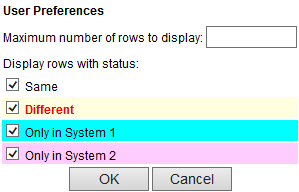Table Set Datasets
Table Set datasets are populated by LiveCompare actions where the results are stored in several tables. For example, the Retrieve Table Set action retrieves the contents of a list of tables from a specified RFC Destination.
When a Table Set dataset is populated, the dataset node in the workflow is labeled to indicate the number of tables that were retrieved or compared. To examine the contents of a Table Set dataset, double-click the dataset node in the workflow diagram, or choose ‘View Details’ from the node’s context menu.
Table Set datasets have the following structure:
<Dataset Name> (Data Set)
<Table Name>
...
Dataset Name (Data Set)
Select the root node in a Table Set dataset to display a summary of each of the tables in the dataset. The summary display has the following columns:
| Column | Description |
|---|---|
| Name | The name of the table. |
| NumRows | The number of rows in the table. |
| Description | The description for the table. |
Table Name
A Table Set dataset contains a <Table Name> node for each of the tables retrieved or compared. If the dataset contains comparison results, each <Table Name> node is labeled with an icon to indicate its comparison status:
| Icon | Description |
|---|---|
|
|
The table is the same in each of the compared systems. |
|
|
The table is different in each of the compared systems. |
|
|
The table exists in the first compared system only. |
|
|
The table exists in the second compared system only. |
|
|
The table was not compared. |
|
|
The table view could not be compared because it is not maintainable with the SAP ‘View Maintenance’ transaction (SM30). |
Select a <Table Name> node to display the table’s contents in the Details pane. The grid control uses the following display conventions:
- Underlined values indicate ID columns for the table. Click an underlined value to open the Row Details screen, which displays field values and descriptions for the selected row.
- Values shaded in green indicate key fields.
- Selected cells are shaded in gray.
If the table contains comparison results, the first column contains an icon to indicate the comparison status of each row:
| Icon | Description |
|---|---|

|
The row is the same in each of the compared tables. |

|
The row is different in each of the compared tables. These rows are shown in red with a yellow background. |
|
|
The row exists in the first compared table only. These rows are shown with a cyan background. |
|
|
The row exists in the second compared table only. These rows are shown with a pink background. |
Click a link in the Icon column to display the Row Details screen for the selected row.
A range of cells may be selected in the grid control by using Left Click+Drag in the column headings, row headings or table body. Alternatively, use Shift+Arrow Keys to select cells using the keyboard. To select the entire table, use Left Click+Drag in Row 0, or choose ‘Select All’ from the grid control’s context menu.
To export the selection to an Excel spreadsheet, choose ‘Export Selection to Excel’ from the grid control’s context menu. To copy the selection to the Windows Clipboard, choose ‘Copy Selection’ from the context menu, or press Ctrl+C.
 Options
Options
Click the ‘Options’ icon to show or hide the Options dialog:

Enter a maximum number of table rows to display in the ‘Maximum number of rows to display:’ field. This value applies to all tables viewed by the current user, and is also stored in the ‘Maximum number of rows/objects to display:’ User Preferences field.
If the table shows comparison results, select the appropriate check boxes in the ‘Display rows with status:’ section to display only those table rows with the selected comparison statuses. Each LiveCompare user may have their own settings, but the settings apply to all table comparison views.
Click ‘OK’ to save your changes.
 Export to
Excel
Export to
Excel
Click the ‘Export to Excel’ icon to export the contents of the selected Table object to Microsoft Excel.